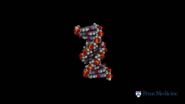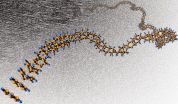NYU Langone scientists identify key factor that maintains stem cell identity
Finding could improve methods of reprogramming adult cells
2014-09-25
(Press-News.org) NEW YORK, September 25, 2014— A protein implicated in several cancers appears to play a pivotal role in keeping stem cells in an immature "pluripotent" state, according to a new study by NYU Langone Medical Center scientists. The study is published online today in Cell Reports.
Stem cells are the perpetual adolescents of the cellular world, uncommitted to any cell fate. In principle, they can be programmed to differentiate into any mature cell type, holding the promise of regenerating tissues and organs. A fuller understanding of their biology, however, is needed.
"Our finding provides a better understanding of the complexity of how the stem cell state is regulated," says Eva M. Hernando-Monge, PhD, associate professor of pathology and a member of the Helen L. and Martin S. Kimmel Center for Stem Cell Biology at NYU Langone Medical Center.
The newly identified stem cell factor is BRD4, a protein associated with several cancers and the target of prospective therapies currently in clinical trials. In 2013, Dr. Hernando-Monge and colleagues found that BRD4 is overexpressed in melanoma cells and helps sustain their proliferation, whereas inhibiting BRD4 greatly slows their growth. The protein appeared to drive cancer in part by keeping cancer cells in a relatively immature, stem cell-like state. Intrigued, Dr. Hernand-Monge wanted to find out what role the protein played in actual stem cells.
In the new study, Dr. Hernando-Monge's team inhibited BRD4's activity in mouse and human embryonic stem cells using BRD4-blocking compounds developed by collaborator Ming-Ming Zhou and colleagues at the Icahn School of Medicine at Mount Sinai. They also used special RNA molecules that block BRD4 gene transcripts, and observed the cells shift out of the stem cell state. As they divided, the cells began to show characteristics of young neurons. Stem cells are thought to maintain a state of quiescence until some signal forces them to divide, producing a differentiated, highly specialized cell.
BRD4 has been known to regulate gene activity by binding to the support structure of DNA, called chromatin, at special switch sites called super-enhancers distributed throughout the genome. These sites are believed to be top-level controllers, orchestrating the distinctive expression patterns of several genes that together determine specific cell types such as nerve or muscle.
"We found that BRD4 occupies the super-enhancer sites of genes that are important for maintaining stem cell identity," says Raffaella Di Micco, PhD, a postdoctoral fellow who conceived the research project with Dr. Hernando-Monge and performed most of the experiments. These genes, including OCT4 and PRDM14, showed steep drops in expression when Dr. Di Micco applied BRD4 inhibitors to stem cells.
"OCT4 also represses neuronal differentiation, so we think that the loss of that repression with BRD4 inhibition is the most likely reason for the induction of neuronal characteristics in the stem cells," says Dr. Di Micco.
OCT4 is also one of the four factors in the standard "OKSM" cocktail used for turning ordinary cells into induced pluripotent stem cells (iPSCs). The new findings suggest that BRD4 enforces stem cell identity from an even higher regulatory level in the cell. "In theory we could replace one or more of those OKSM factors with BRD4, or add it to the cocktail to increase reprogramming efficiency—that's something we're working on now," says Dr. Hernando-Monge.
Conversely, she notes, BRD4 inhibitors could be used to help program cells in the other direction, turning stem cells into baby neurons, for example, which perhaps one day would be used for regenerative therapies.
INFORMATION:
Other contributors to the study were Barbara Fontanals-Cirera, Vivien Low, Panagiotis Ntziachristos, Stephanie K. Yuen, Claudia D. Lovell, Igor Dolgalev, Yoshiya Yonekubo, Iannis Aifantis, and Aristotelis Tsirigos, of NYU Langone Medical Center; and Guangtao Zhang, Elena Rusinova, Guillermo Gerona-Navarro, Marta Cañamero, and Michael Ohlmeyer from the Icahn School of Medicine at Mount Sinai. Raffaella Di Micco is a New York Stem Cell Foundation - Druckenmiller Fellow. Support for the research was provided by the New York Stem Cell Foundation; Lady Tata Memorial Trust for Leukemia; the American Society of Hematology; the Leukemia & Lymphoma Society; the National Cancer Institute (K99CA188293); and the National Institutes of Health (RO1CA133379, RO1CA105129, RO1CA149655, RO1GM088847, R01HG004508, R01CA87658, R01CA155234, R01CA163891, and R21AR062239).
ELSE PRESS RELEASES FROM THIS DATE:
Surprising diversity of antibody family provides clues for HIV vaccine design
2014-09-25
LA JOLLA, CA—September 25, 2014—Scientists at The Scripps Research Institute (TSRI) have described how a single family of antibodies that broadly neutralizes different strains of HIV has evolved remarkably diverse structures to attack a vulnerable site on the virus. The findings provide clues for the design of a future HIV vaccine.
"In a sense, this antibody family takes more than one shot on goal in order to hit divergent forms of HIV," said Ian A. Wilson, the Hansen Professor of Structural Biology and member of the Skaggs Institute for Chemical Biology at TSRI.
"The ...
New genes identified with key role in the development of severe childhood epilepsies
2014-09-25
In the largest collaborative study so far, an international team of researchers, including scientists from VIB and Antwerp University identified novel causes for severe childhood epilepsies. The researchers analyzed the genetic information of 356 patients and their parents. In their analysis, the research teams looked for genes that had acquired new mutations in the children with severe epilepsies when compared to the DNA of the parents. In total, they identified 429 new mutations and in 12% of children, these mutations were considered unequivocally causative for the patient's ...
How the ends of chromosomes are maintained for cancer cell immortality
2014-09-25
VIDEO:
The perpetual proliferation of cancer cells requires a means to maintain telomere length. Alternative lengthening of telomeres (ALT) is a poorly understood mechanism of telomere maintenance that is utilized by...
Click here for more information.
PHILADELPHIA – Maintaining the ends of chromosomes, called telomeres, is a requisite feature of cells that are able to continuously divide and also a hallmark of human cancer. "Telomeres are much like the plastic cap on the ends ...
USC researchers discover dual purpose of cancer drug in regulating expression of genes
2014-09-25
LOS ANGELES — Keck Medicine of USC scientists have discovered new clues about a drug instrumental in treating a certain blood cancer that may provide important targets for researchers searching for cures.
The team investigated whether demethylation of gene bodies induced by the drug 5-Aza-CdR (decitabine), which is used to treat pre-leukemia, could alter gene expression and possibly be a therapeutic target in cancer.
"When we put the drug in cancer cells, we found it not only reactivated some tumor suppressor genes, but it down-regulated the overexpressed oncogene ...
NASA-NOAA's Suomi NPP satellite sees Tropical Storm Kammuri coming together
2014-09-25
When NASA-NOAA Suomi NPP satellite passed over Tropical Storm Kammuri the VIIRS instrument aboard took a visible picture of the storm that showed bands of thunderstorms wrapped around its center. The storm appears to be coming together as circulation improves and bands of thunderstorms have been wrapping into the low-level center of circulation.
NASA-NOAA's Suomi NPP satellite passed over Tropical Storm Kammuri on Sept. 25 at 03:13 UTC (Sept. 24 at 11:13 p.m. EDT) and the Visible Infrared Imaging Radiometer Suite (VIIRS) instrument aboard captured a visible picture of ...
Researchers engineer 'Cas9' animal models to study disease and inform drug discovery
2014-09-25
Cambridge, MA, September 25, 2014 — Researchers from the Broad Institute and Massachusetts Institute of Technology have created a new mouse model to simplify application of the CRISPR-Cas9 system for in vivo genome editing experiments. The researchers successfully used the new "Cas9 mouse" model to edit multiple genes in a variety of cell types, and to model lung adenocarcinoma, one of the most lethal human cancers. The mouse has already been made available to the scientific community and is being used by researchers at more than a dozen institutions. A paper describing ...
Satellite catches an oval-shaped Tropical Storm Rachel
2014-09-25
NOAA's GOES-West satellite spotted the eighteenth tropical depression of the Eastern Pacific grow into a tropical storm that was renamed Rachel today, Sept. 25, 2014. Wind shear is affecting the tropical storm, however, so it doesn't have a rounded appearance on satellite imagery.
Tropical Depression 18-E formed on Wednesday, Sept. 24 around 11 a.m. EDT about 285 miles (460 km) south-southwest of Manzanillo, Mexico. Manzanillo is a city in the Manzanillo municipality of the Mexican state of Colima on the country's west coast.
In an infrared image from NOAA's GOES-West ...
Can genetic engineering help food crops better tolerate drought?
2014-09-25
New Rochelle, NY, September 25, 2014—The staggering growth rate of the global population demands innovative and sustainable solutions to increase food production by as much as 70-100% in the next few decades. In light of environmental changes, more drought-tolerant food crops are essential. The latest technological advances and future directions in regulating genes involved in stress tolerance in crops is presented in a Review article in OMICS: A Journal of Integrative Biology, the peer-reviewed interdisciplinary journal published by Mary Ann Liebert, Inc., publishers. ...
Goats better than chemicals for curbing invasive marsh grass
2014-09-25
DURHAM, N.C. -- Herbivores, not herbicides, may be the most effective way to combat the spread of one of the most invasive plants now threatening East Coast salt marshes, a new Duke University-led study finds.
Phragmites australis, or the common reed, is a rapid colonizer that has overrun many coastal wetlands from New England to the Southeast. A non-native perennial, it can form dense stands of grass up to 10 feet high that block valuable shoreline views of the water, kill off native grasses, and alter marsh function.
Land managers traditionally have used chemical ...
Smallest-possible diamonds form ultra-thin nanothread
2014-09-25
Washington, D.C.— A team including Carnegie's Malcolm Guthrie and George Cody has, for the first time, discovered how to produce ultra-thin "diamond nanothreads" that promise extraordinary properties, including strength and stiffness greater than that of today's strongest nanotubes and polymer fibers. Such exceedingly strong, stiff, and light materials have an array of potential applications, everything from more-fuel efficient vehicles or even the science fictional-sounding proposal for a "space elevator." Their work is published in Nature Materials.
The team—led by ...
LAST 30 PRESS RELEASES:
Numbers in our sights affect how we perceive space
SIMJ announces global collaborative book project in commemoration of its 75th anniversary
Air pollution exposure and birth weight
Obstructive sleep apnea risk and mental health conditions among older adults
How talking slows eye movements behind the wheel
The Ceramic Society of Japan’s Oxoate Ceramics Research Association launches new international book project
Heart-brain connection: international study reveals the role of the vagus nerve in keeping the heart young
Researchers identify Rb1 as a predictive biomarker for a new therapeutic strategy in some breast cancers
Survey reveals ethical gaps slowing AI adoption in pediatric surgery
Stimulant ADHD medications work differently than thought
AI overestimates how smart people are, according to HSE economists
HSE researchers create genome-wide map of quadruplexes
Scientists boost cell "powerhouses" to burn more calories
Automatic label checking: The missing step in making reliable medical AI
Low daily alcohol intake linked to 50% heightened mouth cancer risk in India
American Meteorological Society announces Rick Spinrad as 2026 President-Elect
Biomass-based carbon capture spotlighted in newly released global climate webinar recording
Illuminating invisible nano pollutants: advanced bioimaging tracks the full journey of emerging nanoscale contaminants in living systems
How does age affect recovery from spinal cord injury?
Novel AI tool offers prognosis for patients with head and neck cancer
Fathers’ microplastic exposure tied to their children’s metabolic problems
Research validates laboratory model for studying high-grade serous ovarian cancer
SIR 2026 delivers transformative breakthroughs in minimally invasive medicine to improve patient care
Stem Cell Reports most downloaded papers of 2025 highlight the breadth and impact of stem cell research
Oxford-led study estimates NHS spends around 3% of its primary and secondary care budget on the health impacts of heat and cold in England
A researcher’s long quest leads to a smart composite breakthrough
Urban wild bees act as “microbial sensors” of city health.
New study finds where you live affects recovery after a hip fracture
Forecasting the impact of fully automated vehicle adoption on US road traffic injuries
Alcohol-related hospitalizations from 2016 to 2022
[Press-News.org] NYU Langone scientists identify key factor that maintains stem cell identityFinding could improve methods of reprogramming adult cells








